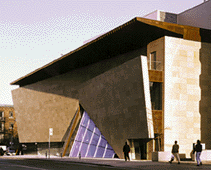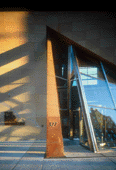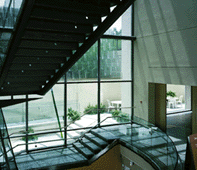|
The Challenge:
The Bata Shoe Museum includes every kind of footwear imaginable, with 10,000 items providing a compelling view into human history. Sonja Bata presented us with a simple mandate: to design a "small gem of a museum." The Bloor Street location in downtown Toronto is ideal - opposite the St. George subway station, just blocks away from the Royal Ontario Museum, and at the northern edge of the University of Toronto. Still, we recognized that, as one of Canada's few privately financed museums, the Bata Shoe Museum needed a bold design approach to engage international and local audiences. And this had to be accomplished on a tiny site with severe height, setback and density restrictions.

The Solution:
The building's footprint takes advantage of all available space, stretching to the property line along Bloor and St. George Streets and the rear setback line at the south and stopping millimeters short of the neighbouring high-rise to the west. The result, as many people have observed, is a three-storey building with the proportions of a shoebox!
 
But this is no ordinary shoebox. From a distance, the building's most striking feature is its wall treatment. Canted inward at street level, the north and west walls are clad with a French limestone with the colour, luminosity, and texture of raw leather, producing an intriguing display of light, shade, and shadow throughout the day. On sunny days the receding and intersecting wall planes are animated by the sun's reflection off the building on the opposite side of the street. As the late-afternoon sun streams down Bloor Street, the limestone takes on a golden glow that gradually shifts to mauve-magenta as the sun sets.
The Museum's entrance is designed to intrigue and invite. A two-storey-high transparent glass wedge explodes from the shoebox, breaks the limestone wall in two (one fragment becoming a parapet for an upper balcony), and spills out onto the sidewalk, giving passers-by a view through the lobby and past the central, cantilevered steel staircase to the 42-foot-high glass window created by artist Lutz Haufschild.
 
The Result:
Shortly after receiving a City of Toronto Urban Design Award of Excellence, the Bata Shoe Museum was described by art and architecture critic John Bentley Mays as "a visual jolt into the crossing of St. George and Bloor that, for the first time in its history, makes the intersection swing."
With 65,000 visitors passing through its doors annually, the Bata Shoe Museum is a popular venue for private functions. But it's also becoming one of Toronto's most recognized architectural and cultural attractions. It was recently featured in an 8-page spread in Readers' Digest magazines around the world. And its attention-catching design is the dramatic setting for the music video "Lucky Day" by Canadian pop artists The Wild Strawberries.
|